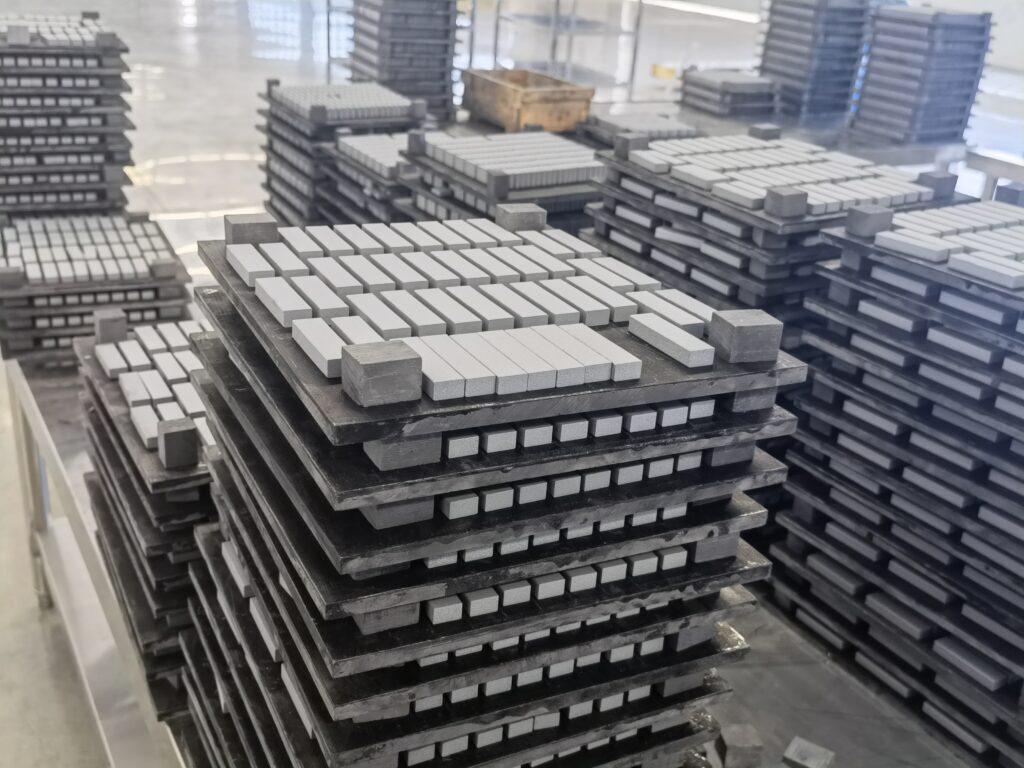- Carbide industry
Cemented carbide is an alloy material with extremely high hardness and good wear resistance that is made of tungsten carbide powder of high-hardness refractory metal as the main component and metals such as cobalt and nickel as binders. It is ball milled, pressed, and sintered. .
The high hardness and high wear resistance of cemented carbide allow it to be manufactured into various mining tools, cutting tools, wear-resistant tools, etc. It is widely used in engineering machinery, metal cutting machine tools, automobile manufacturing, electronic information, aerospace and military industry, etc. field, known as the "teeth of industry".
Cemented carbide is usually divided according to the size of tungsten carbide grains and its application fields. The grain size largely determines the performance and application fields of cemented carbide.
Generally speaking, the smaller the grain size, the higher the hardness of the cemented carbide and the better the wear resistance, but at the same time the toughness is reduced and the impact resistance is poor; the larger the grain size, the better the impact resistance and toughness of the cemented carbide. , the hardness and wear resistance are reduced.
- Characteristics of the cemented carbide industry
(1) my country is the country with the largest output of cemented carbide
Carbide originated in Germany in the 1920s, and was subsequently produced in the United States, Austria, Sweden, Japan and other countries.
Our country's cemented carbide industry began in the late 1940s. After more than 70 years of development since the founding of the People's Republic of China, our country has become the country with the largest cemented carbide output. In 2019, domestic cemented carbide production reached 36,500 tons, accounting for approximately 40% of global production.
Our country is the world's largest tungsten resource reserve country, with tungsten reserves accounting for 58% of global tungsten resources, ranking first.
Hunan and Jiangxi provinces are the provinces with the richest tungsten resource reserves in our country, and their combined reserves account for 50% of the country's total.
As a raw material-oriented industry, our country's cemented carbide industry shows the characteristics of regional distribution based on the distribution of tungsten ore resources in our country, and is mainly concentrated in areas where tungsten ores are concentrated such as Hunan and Jiangxi.
In this area, leading domestic cemented carbide companies, represented by Chinatungsten High-tech and Zhangyuan Tungsten Industry, have emerged, forming a high industry concentration. In 2019, the output of our country's top ten cemented carbide manufacturers accounted for 59% of the country's total output.
(2) Raw material prices affect the industry’s gross profit margin level
In the cost structure of cemented carbide, material costs account for a relatively high proportion, with raw materials accounting for approximately 70% of its production costs.
Tungsten carbide and cobalt powder, as the main raw materials of cemented carbide, are rare and non-renewable metals. Although they are widely distributed, their content is low and mining is difficult. Moreover, due to the state's total control and management of tungsten mining, the supply side is relatively Stable, market demand and inventory changes have a greater impact on prices.
(3) There is huge room for domestic substitution, and the scale of exports continues to increase.
Since the 21st century, our country's cemented carbide industry has achieved rapid development, but it is still at the middle and low end of the world's cemented carbide industry chain. Scientific research investment, R&D level and capabilities, process level and equipment level, market competitiveness, enterprise There is still a big gap between profitability, product technology, quality and grade and international advanced cemented carbide companies.
Mainly reflected in the low level of industry-university-research integration, low R&D investment, lack of high-end technical talents, few major breakthroughs in cutting-edge technologies and key areas of cemented carbide deep processing, and few original core technological achievements, resulting in the decline of our country's hard alloy industry. The proportion of deep processing of alloy products fluctuates between 18% and 27%, which is still far behind the proportion of deep processing of cemented carbide in Western developed countries.
At present, some domestic carbide products are still mainly medium and low-end, which cannot meet the needs of domestic high-end manufacturing. High-tech, high value-added carbide products such as high-end carbide CNC blades still need to be imported from abroad.
According to the import and export data released by the General Administration of Customs, the average unit price of "other cemented carbide metalworking machinery knives and sheets" imported into our country is about 6 to 8 times the export price. The degree of deep processing by domestic enterprises needs to be improved urgently.
In order to solve the current situation of low deep processing of products in the domestic cemented carbide industry and insufficient self-sufficiency rate of high-end cemented carbide, with the support of a series of encouraging policies, our national cemented carbide industry has continued to grow in scale through resource integration, optimization and reorganization.
At the same time, for a series of "stuck" key areas, through introduction, absorption and independent innovation, we have made progress in raw material production, hard material product and material development, process and equipment application, quality testing, recycling of scrap alloys, etc. A series of major advances.
(4) Different types of cemented carbide face different development opportunities.
Carbide can be divided into mining tool alloys, cutting tool alloys, wear-resistant tool alloys and other alloys according to their downstream application fields. There are large differences in the development opportunities and market spaces faced by different types of cemented carbide.

- Development Trend of Cemented Carbide Industry
(1) The process of industrial integration is accelerating and the number of acquisitions within the industry is increasing.
The cemented carbide and tool industry belongs to the middle and lower reaches of the cemented carbide industry chain. Its upstream is the mining and smelting industry of metal compounds and powders such as tungsten and cobalt, and its downstream is mechanical processing, petroleum and mineral excavation, automobile manufacturing and aerospace. and other application fields.
Due to the large number of cemented carbide segmented products and the wide range of downstream applications, there have been certain barriers between market segments for a long time. Enterprises in the industry generally increase their market size and enhance their market size through the continuous development of new products and acquisitions and mergers within the industry chain. Company competitiveness.
The development process of leading foreign carbide and tool manufacturing industry companies is often accompanied by multiple mergers and acquisitions in the industry. Taking Sandvik as an example, since 2018 it has completed acquisitions of the American Dura-Mill Company and Kunshan Osik Precision Tools Co., Ltd. The acquisition of many companies in the industry, such as the American Wetmore Company, has further expanded the business coverage, enhanced the control over subdivided areas, and improved the overall customer service capabilities.
In recent years, our country's cemented carbide companies have gradually accelerated the pace of industrial integration, such as Chinatungsten High-tech's acquisition of German HPTec, a micro tool company in the PCB industry, and Xianglu Tungsten's acquisition of Loncintai Tungsten.
(2) Localization of high-end carbide and tools
Our country is in a critical period of transformation and upgrading of the manufacturing industry, and high-end CNC tools, precision parts and molds, etc., as key industrial spare parts to improve manufacturing levels and labor efficiency, have long been dependent on imports.
Among them, high-end CNC tools are used in key fields such as aerospace, military industry and electronic information, which are related to national economic security and national defense security. Import dependence has become an obstacle restricting the transformation and upgrading of our country's manufacturing industry.
At present, some domestic cemented carbide products are still mainly low-end and homogeneous products. The proportion of deep processing and finishing of cemented carbide is insufficient. Break through the technical barriers of high-end cemented carbide and realize the domestic production of high-end cemented carbide and its tools. Chemicalization is the main direction for the development of domestic cemented carbide enterprises.
(3) The overall service capabilities of domestic enterprises need to be improved
Compared with foreign companies in the same industry, domestic carbide industry companies generally have the characteristics of single products, insufficient understanding of customer needs, or inability to respond to customer needs in a timely manner. They are unable to provide customers with overall solutions, resulting in the export of domestic companies with low-end, Mainly processed products, with insufficient international market share and low profit margins.
The world's leading cemented carbide tool manufacturer is able to provide customers with systematic and complete solutions based on its rich product categories and high technical content, focusing on customers' systemic needs, and can promptly grasp changes in customers' actual needs and actively adjust Product structure, strengthen supporting services, transform from a single tool manufacturer to a comprehensive service provider.
In order to participate in the international market competition, domestic carbide tool companies need to continuously improve their customer service capabilities and transform from single product output to comprehensive solution output in order to further enhance corporate competitiveness and enhance corporate profitability. - Industry competition
The cemented carbide industry chain where major companies in the industry are located shows a trend of upstream and downstream integration. Upstream raw material mining and smelting companies have extended to the cemented carbide and tool manufacturing fields, forming a through-carbide industry represented by Chinatungsten High-tech. A leading enterprise in the entire industry chain.





